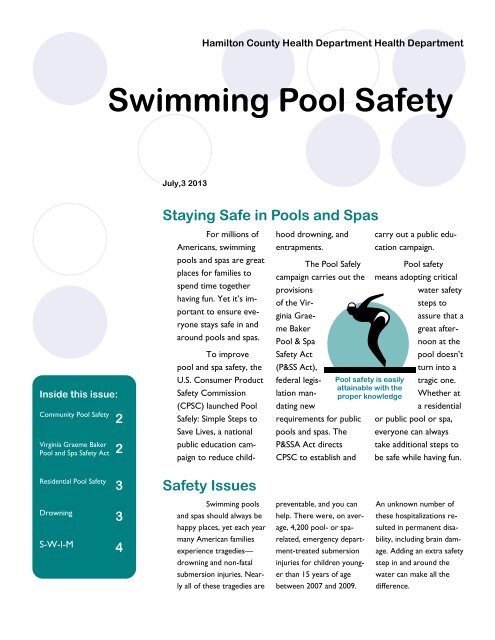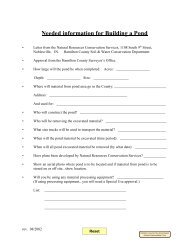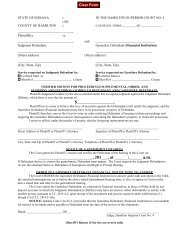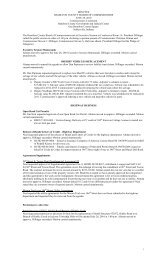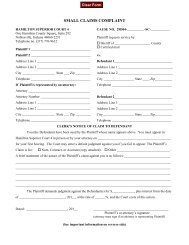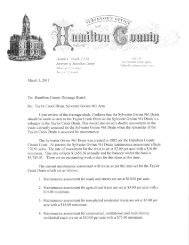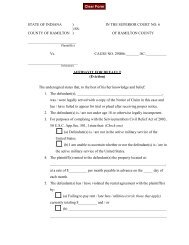Swimming Pool Safety - Hamilton County, Indiana
Swimming Pool Safety - Hamilton County, Indiana
Swimming Pool Safety - Hamilton County, Indiana
You also want an ePaper? Increase the reach of your titles
YUMPU automatically turns print PDFs into web optimized ePapers that Google loves.
<strong>Hamilton</strong> <strong>County</strong> Health Department Health Department<br />
<strong>Swimming</strong> <strong>Pool</strong> <strong>Safety</strong><br />
July,3 2013<br />
Staying Safe in <strong>Pool</strong>s and Spas<br />
Inside this issue:<br />
Community <strong>Pool</strong> <strong>Safety</strong><br />
2<br />
Virginia Graeme Baker<br />
<strong>Pool</strong> and Spa <strong>Safety</strong> Act 2<br />
For millions of<br />
Americans, swimming<br />
pools and spas are great<br />
places for families to<br />
spend time together<br />
having fun. Yet it’s important<br />
to ensure everyone<br />
stays safe in and<br />
around pools and spas.<br />
To improve<br />
pool and spa safety, the<br />
U.S. Consumer Product<br />
<strong>Safety</strong> Commission<br />
(CPSC) launched <strong>Pool</strong><br />
Safely: Simple Steps to<br />
Save Lives, a national<br />
public education campaign<br />
to reduce childhood<br />
drowning, and<br />
entrapments.<br />
The <strong>Pool</strong> Safely<br />
campaign carries out the<br />
provisions<br />
of the Virginia<br />
Graeme<br />
Baker<br />
<strong>Pool</strong> & Spa<br />
<strong>Safety</strong> Act<br />
(P&SS Act),<br />
federal legislation<br />
mandating<br />
new<br />
requirements for public<br />
pools and spas. The<br />
P&SSA Act directs<br />
CPSC to establish and<br />
<strong>Pool</strong> safety is easily<br />
attainable with the<br />
proper knowledge<br />
carry out a public education<br />
campaign.<br />
<strong>Pool</strong> safety<br />
means adopting critical<br />
water safety<br />
steps to<br />
assure that a<br />
great afternoon<br />
at the<br />
pool doesn’t<br />
turn into a<br />
tragic one.<br />
Whether at<br />
a residential<br />
or public pool or spa,<br />
everyone can always<br />
take additional steps to<br />
be safe while having fun.<br />
Residential <strong>Pool</strong> <strong>Safety</strong><br />
3<br />
<strong>Safety</strong> Issues<br />
Drowning<br />
3<br />
<strong>Swimming</strong> pools<br />
and spas should always be<br />
happy places, yet each year<br />
preventable, and you can<br />
help. There were, on average,<br />
4,200 pool- or spa-<br />
An unknown number of<br />
these hospitalizations resulted<br />
in permanent disa-<br />
S-W-I-M<br />
4<br />
many American families<br />
experience tragedies—<br />
related, emergency department-treated<br />
submersion<br />
bility, including brain damage.<br />
Adding an extra safety<br />
drowning and non-fatal<br />
injuries for children young-<br />
step in and around the<br />
submersion injuries. Nearly<br />
all of these tragedies are<br />
er than 15 years of age<br />
between 2007 and 2009.<br />
water can make all the<br />
difference.
Community <strong>Pool</strong> <strong>Safety</strong><br />
Many Families visit indoor and outdoor public pools during the swimming<br />
season and year round. Public pool owners and operators should follow local, state,<br />
and federal regulations to ensure safety of their facilities. Every community pool is<br />
required by the county to have the following equipment and regulations<br />
Having the Appropriate Equipment<br />
Are there fences that limit the access to the pool and spa?<br />
Is there life saving equipment such as life rings and reaching poles available?<br />
Is there an emergency phone (land-line) available on site?<br />
Is there a first-aid kit available on site and is that kit properly stocked?<br />
Is there a stretcher with head stabilizer on site?<br />
Are the new drain covers in compliance with the Virginia Graeme Baker <strong>Pool</strong> and Spa<br />
<strong>Safety</strong> Act?<br />
Proper <strong>Safety</strong> Steps<br />
Does the staff take water samples twice a day and keep these records on file?<br />
Are there rules and regulation signs posted? Including bather loads, safety rules, and diaper<br />
rules?<br />
Has the pool been inspected by the <strong>Hamilton</strong> <strong>County</strong> Health Department to ensure its<br />
safety around the pool, as well as, the chemicals inside the pool?<br />
“Two men who<br />
eventually freed<br />
Graeme from the spa<br />
pulled so hard that<br />
the drain cover broke<br />
from the force”<br />
Page 2<br />
Virginia Graeme Baker <strong>Pool</strong> and Spa <strong>Safety</strong> Act<br />
Who is Virginia Graeme Baker?<br />
The Virginia Graeme Baker <strong>Pool</strong> & Spa <strong>Safety</strong> Act (P&SS Act) takes its name from Virginia<br />
Graeme Baker,<br />
In June 2002, Graeme became stuck to a hot tub drain and was unable to pull herself free.<br />
Efforts by her mother to pull Graeme from the drain proved unsuccessful. Two men who<br />
eventually freed Graeme from the spa pulled so hard that the drain cover broke from the<br />
force.<br />
Her mother, Nancy Baker, worked tirelessly to advocate for pool and spa safety. Mrs.<br />
Baker, her family and Safe Kids Worldwide actively lobbied Congress to win support for a<br />
law to require anti-entrapment drain covers and other safety devices .
Residential <strong>Pool</strong> <strong>Safety</strong><br />
Adding as many water safety steps as possible is the best way to assure a safe and fun experience<br />
in a residential swimming pool or spa. Parents and families can build on their current safety practices by<br />
adopting water safety steps at home pools and spas.<br />
Staying Close, Being Alert Watching Children in and Around the <strong>Pool</strong><br />
Teach children basic water safety tips.<br />
Keep children away from pool drains, pipes and other openings to avoid entrapments .<br />
If a child is missing, look for him or her in the pool or spa first.<br />
Have a portable telephone close by at all times when you or your family are using a pool or spa.<br />
Share safety instructions with family, friends and neighbors.<br />
Learning and Practicing Water <strong>Safety</strong> Skills<br />
Learn how to swim and teach your child how to swim.<br />
Learn to perform CPR on children and adults, and update those skills regularly.<br />
Understand the basics of life-saving so that you can assist in a pool emergency.<br />
Having the Appropriate equipment for Your <strong>Pool</strong><br />
Install a four-foot or taller fence around the pool and spa and use self-closing and self-latching gates; ask your<br />
neighbors to do the same at their pools.<br />
Install and use a lockable safety cover on your spa.<br />
Install pool and gate alarms to alert you when children go near the water.<br />
Consider using a surface wave or underwater alarm.<br />
Drowning<br />
Every day, about ten people die from unintentional drowning. Of these,<br />
two are children aged 14 or younger. Drowning ranks fifth among the<br />
leading causes of unintentional injury death in the United States.<br />
About one in five people who die from drowning are children 14 and younger. For<br />
every child who dies from drowning, another five receive emergency department<br />
care for nonfatal submersion injuries.<br />
“Children ages 1 to<br />
4 have the highest<br />
drowning rates.”<br />
Nearly 80% of people who die from drowning are male.<br />
Children ages 1 to 4 have the highest drowning rates.<br />
The fatal drowning rate of African American children ages 5 to 14 is almost three<br />
times that of white children in the same age range.<br />
Page 3
The <strong>Hamilton</strong> <strong>County</strong> Health Department is dedicated to the purpose of<br />
communicable disease prevention and health promotion for residents of all ages in<br />
<strong>Hamilton</strong> <strong>County</strong> and protecting the environment in which they live. The department<br />
maintains programs of education, regulatory enforcement, and provides<br />
<strong>Hamilton</strong> <strong>County</strong><br />
Health Department<br />
18030 Foundation Drive<br />
Suite A<br />
Noblesville, IN 46060<br />
Office:<br />
(317) 776-8500<br />
Office Fax:<br />
(317) 776-8506<br />
E-mail<br />
Health@hamiltoncounty.in.gov<br />
health services devoted to the promotion of a healthy environment in <strong>Hamilton</strong><br />
<strong>County</strong>.<br />
The staff of the <strong>Hamilton</strong> <strong>County</strong> Health Department is devoted to meeting<br />
the challenge of public health issues, which arise on a daily basis. The department<br />
has balanced itself to provide services to residents ranging from Vital Records,<br />
Environmental Health, Health Education and Public Health Nursing.<br />
W ERE ON THE WEB<br />
WWW. HAMILTONCOU<br />
NTY. IN. GOV<br />
S-W-I-M<br />
S is for SUNSCREEN - Don't go outside without it<br />
W is for WALK - Don't run around pools<br />
I is for INSIDE - Go in if it starts to rain or thunder<br />
Developed by<br />
Zack Langbeen<br />
M is for MAKE - sure a grownup is always with you at the pool<br />
Health Education Intern<br />
<strong>Hamilton</strong> <strong>County</strong> Health Department


